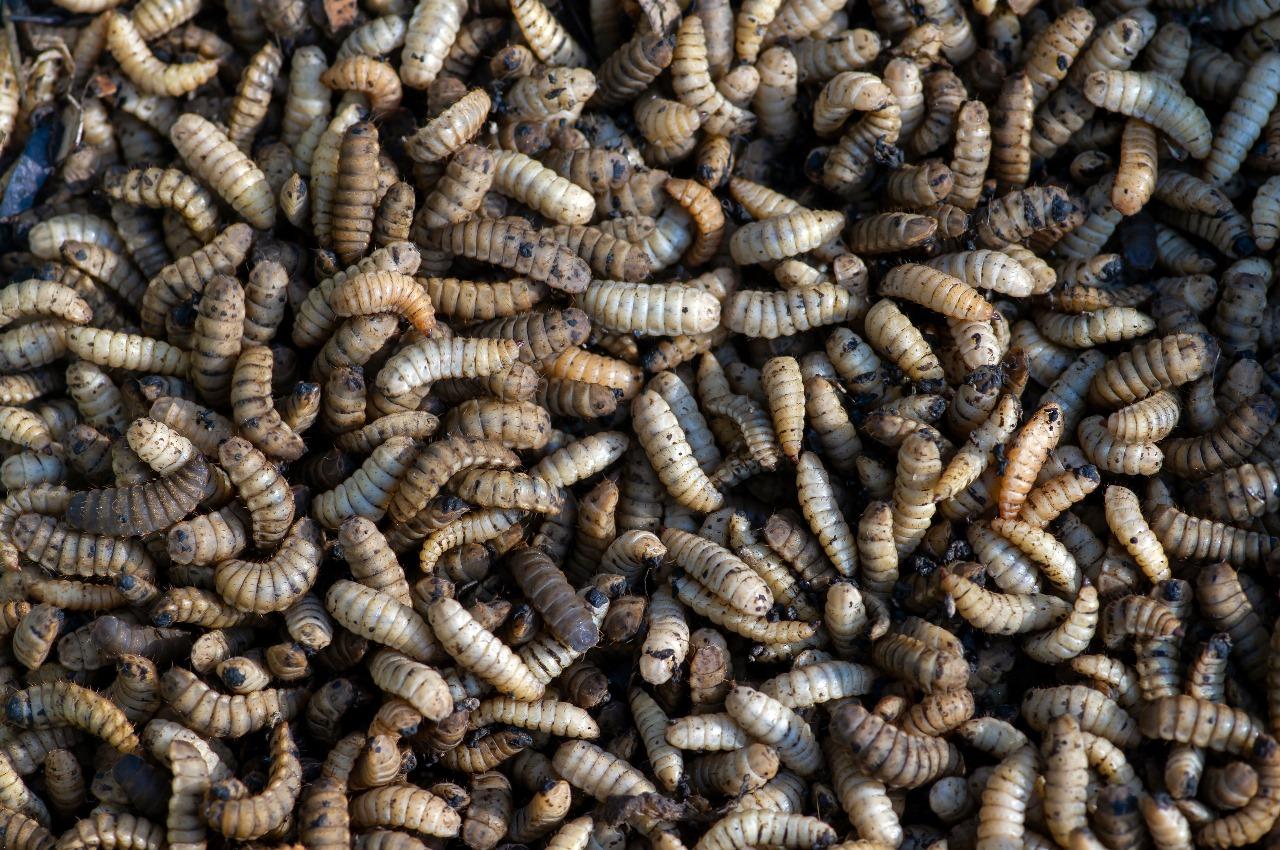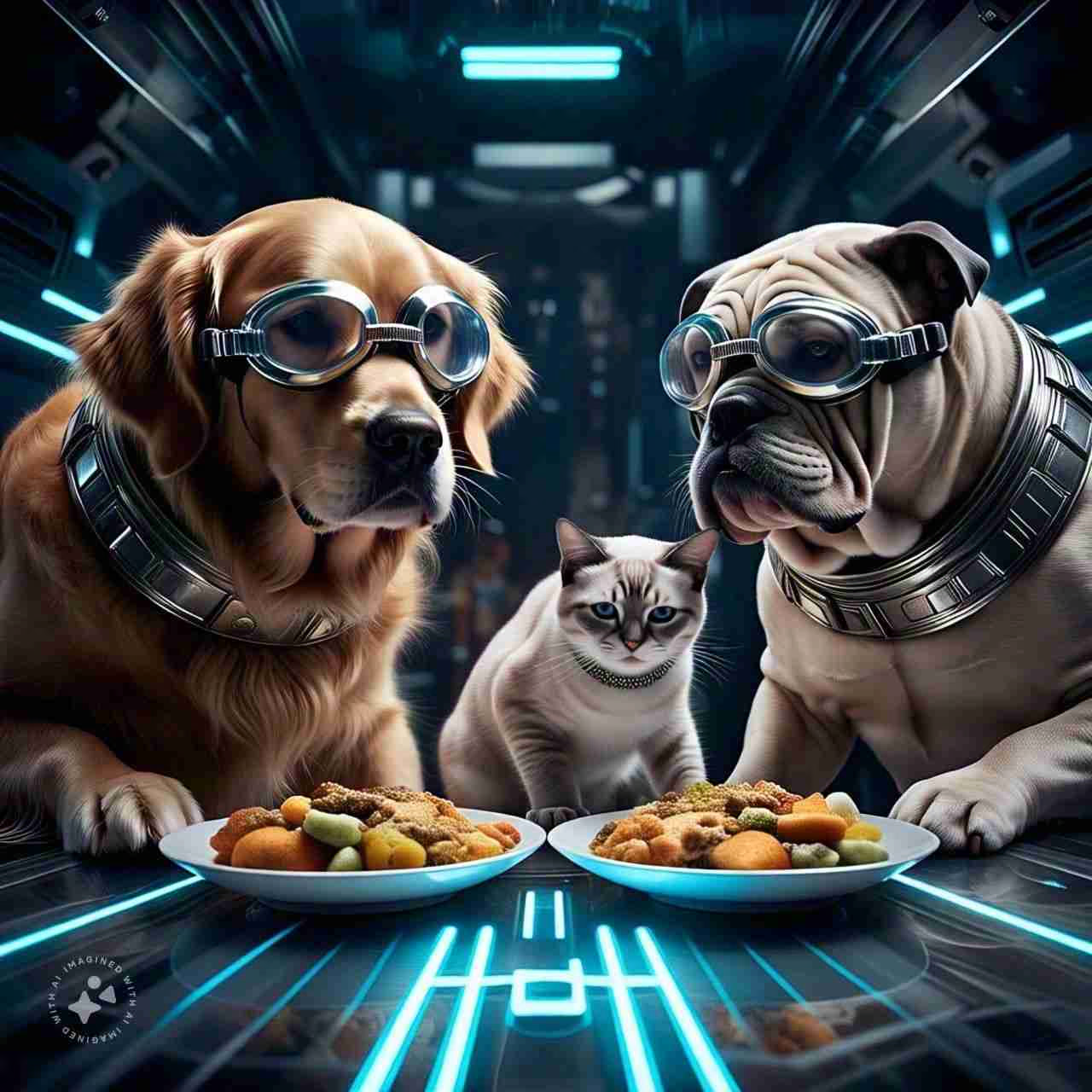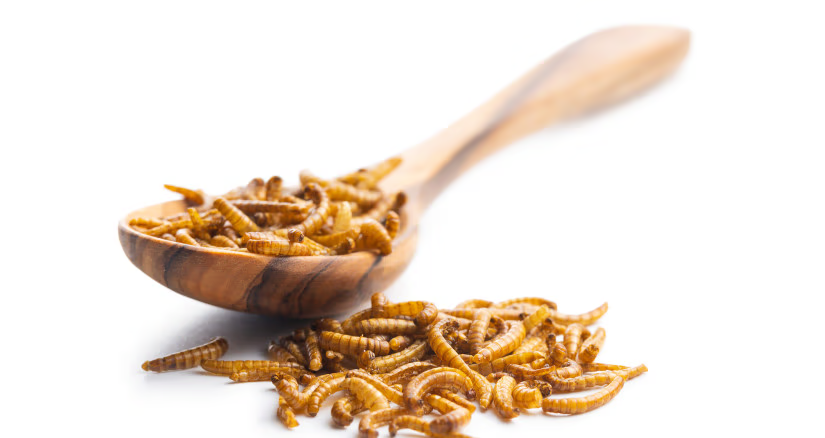Common types of insects used in the production of feed
There are currently seven species of insects that are authorised in the EU for use in pet food2 . The top three most prevalent species of farmed insects for use in pet foods are illustrated below.
What is unique about insects?
Insects are able to eat by-products and foods that are surplus to human requirements and efficiently convert them into quality proteins and produce valuable byproducts such as chitin and insect oil. This biological reprocessing of by-products is the key concept underpinning the use of insect protein in animal feeds. Moreover, the excrements of insects, so called insect frass, can be used as a natural fertilizer.
Different forms of insect-based ingredients
The insects are mainly rendered into high protein meal (e.g. 55% protein with an average 80% digestibility) (Bosch et al. 2020) and fats, or made into puree which is stored frozen. Whole dried insect alternatives are available, but these are mainly targeted at the bird and fish market.
Nutritional profile & potential added benefits
Insects such as black soldier fly larvae are rich in protein and have a clear potential in animal nutrition. Additionally, insects can have high concentration of fats, minerals, and vitamins, depending on what they are fed and on their larval stage at the time of harvest (picture below).
Palatability
Studies show that cats and dogs may have different tastes when it comes to insects, and that the type of insect and the amount included can affect the food acceptability. Test reports by pet food companies showed that dogs may favour dry foods with black soldier fly larvae meal over those with yellow mealworm meal (YMW), while cats may favour the YMW-based food over foods with black soldier fly larvae meal (Bosch et.al. 2021).
Environmental Benefits
Insects require significantly fewer resources than traditional livestock. Life cycle assessment studies indicate that insect proteins can have a lower environmental impact (eg., lower land use, lower water use, less emission of CO2 – equivalents) than animal proteins from ruminants, pigs, and poultry when produced using renewable energy and fed with agricultural by-products (Van Huis and Oonincx 2017). These environmental impacts may further diminish as production facilities scale up and increase their capacity in coming years.
A gram of edible protein from beef requires 8-14 times more land and 5 times more water than a gram of protein from mealworms and has a higher environmental impact with respect to greenhouse gas emissions. Broiler chickens are associated with 1.3 – 2.7 times higher emissions, and beef cattle emit 6 -13 times more CO2 equivalents than mealworms, when measured in terms of 1 g of edible protein (Oonincx and De Boer 2012). As processing and insect feed is producer-dependent and technology is evolving rapidly, using suppliers' primary data is recommended when evaluating their environmental impact.
Insects are also efficient feed converters, depending on their species and the diet consumed. Mealworm and house crickets have been reported to convert some feed sources into body mass with similar efficiency to poultry (Oonincx et al. 2015). In conclusion, insects provide a sustainable source of animal protein, and producing valuable by-products such as chitin and insect oil.
Consumer attitudes and acceptance levels
Market research work undertaken by PROteINSECT (2016) indicated that a high percentage of consumers demonstrate acceptability of insects as a protein source in animal feed3 . Consumers also showed a desire for more information about insects as an alternative sustainable protein source.
Growing media attention and campaigns by farmers, academics, non-profit organizations (such as IPIFF4) and pet food companies are helping to increase acceptability of insect-based ingredients among pet professionals and owners.
The increased acceptability of insect-based pet food ingredients has been further bolstered by research which indicates that insects are a nutritious source of protein and other essential nutrients, as well as potentially being more sustainable than conventional meat sources for pet food.Moreresearchandlong-termstudiesareneededto substantiate these findings.
INTERESTING FACTS
• Farmed insects are typically fed on a variety of plant-based diets, such as spent brewery grains, fruits, vegetables, and other vegetable or cereal by-products.
• The initial farms mainly began in the tropics but now span the globe. Today, there are over 100 farms in European countries such as Germany, The Netherlands, France, Poland, Belgium, and UK.
Currently, over 50% of insect production is being directed towards pet food. According to a RABO Bank report, the demand for insect protein is predicted to rise from 120,000 metric tons to half a million metric tons by 2030 (De Jong & Nikolik 2021).
Source: FEDIAF
References:
1 These are specific, authorised, species of insects that are commercially produced, under controlled conditions, for animal feed.
2 Regulation No. 2017/893 authorised the use of insect proteins originating from seven insect species which are neither pathogenic nor have other adverse effects on plant, animal, or human health.
PROteINSECT (2016). 'Insect Protein – Feed for the Future. Addressing the need for feeds of the future today' at proteinsect.eu/fileadmin/user_upload/press/proteinsect- whitepaper-2016.pdf (accessed on 22 Sep 2020).
Van Huis, A., & Oonincx, D. G. (2017). The environmental sustainability of insects as food and feed. A review. Agronomy for Sustainable Development, 37, 1-14.
Van Huis, A., Rumpold, B. A., Van der Fels-Klerx, H. J., & Tomberlin, J. K. (2021). Advancing edible insects as food and feed in a circular economy. Journal of Insects as Food and Feed, 7(5), 935-948.
3 70% of those surveyed said that it is totally acceptable to feed insect protein to farmed animals.
4 The International Platform of Insects for Food and Feed.
You could be interested: Insect Protein in Pet Food: Sustainable Breakthrough or Strategic Media Push?
Insect Based
06/11/2024































